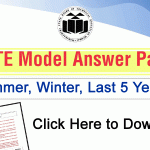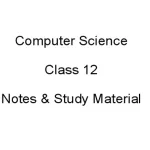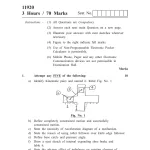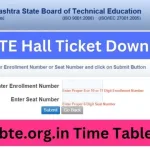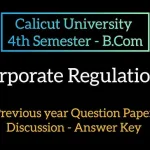What is the difference between RAM and ROM?
RAM (Random Access Memory) is volatile and is used for storing data that is actively being used by the computer. ROM (Read-Only Memory) is non-volatile and stores critical data that does not change.
Explain the concept of Object-Oriented Programming.
Object-Oriented Programming (OOP) is a programming paradigm based on the concept of “objects.” These objects can contain data in the form of fields and code in the form of procedures. The main features of OOP are encapsulation, inheritance, and polymorphism.
What is a database?
A database is an organized collection of structured information or data, typically stored electronically in a computer system. It allows for efficient data retrieval, modification, and storage.
What do you understand by the term ‘algorithm’?
An algorithm is a step-by-step procedure or formula for solving a problem. It is a systematic approach to performing tasks, such as calculating sums or sorting data.
Define ‘multithreading’.
Multithreading refers to the ability of a CPU to provide multiple threads of execution concurrently. This is a way of improving the performance of applications by running multiple operations in parallel.
Subject 2: Mechanical Engineering
What is the difference between a solid and a fluid?
A solid maintains its shape and volume, while a fluid (liquids and gases) can flow and does not have a fixed shape. Fluids take the shape of their container.
Explain the concept of torque.
Torque is a measure of the rotational force applied to an object. It is calculated by multiplying the force by the distance from the pivot point at which the force is applied.
What is the function of a camshaft in an engine?
The camshaft controls the timing of the opening and closing of the engine’s intake and exhaust valves. It is essential for the engine’s performance, fuel efficiency, and emission control.
What are the types of gears used in mechanical systems?
The common types of gears include spur gears, bevel gears, helical gears, and worm gears. Each type is designed for different applications, based on how the gears interact with each other.
Define the term ‘heat transfer’.
Heat transfer is the process by which heat moves from one object to another due to a temperature difference. It can occur via conduction, convection, or radiation.
Subject 3: Electrical Engineering
What is Ohm’s Law?
Ohm’s Law states that the current through a conductor between two points is directly proportional to the voltage across the two points and inversely proportional to the resistance. The formula is V = IR.
Explain the concept of alternating current (AC).
Alternating current (AC) is an electric current that reverses direction periodically, in contrast to direct current (DC), where the current flows in one direction.
What are the types of transformers?
Transformers are categorized into two main types: step-up transformers (increase voltage) and step-down transformers (decrease voltage). They are used in power distribution systems.
What is a diode and how does it work?
A diode is a semiconductor device that allows current to flow in one direction only. It is used in circuits to convert AC to DC or to protect against reverse polarity.
What is the difference between a series and parallel circuit?
In a series circuit, all components are connected in a single path, so the current is the same throughout. In a parallel circuit, components are connected in multiple paths, so the voltage remains constant across each branch.
Subject 4: Civil Engineering
What is a load-bearing wall?
A load-bearing wall is a structural wall that supports the weight of the floors or roof above it, in addition to its own weight. It transfers loads down to the foundation.
Explain the purpose of concrete in construction.
Concrete is a construction material made by mixing cement, water, and aggregates. It is used because it is strong, durable, and can be molded into any shape for building structures.
What is the significance of surveying in civil engineering?
Surveying is crucial in civil engineering for determining the boundaries of a property, designing roads, bridges, and other structures. It ensures accuracy in construction projects.
What is the difference between steel reinforcement and concrete reinforcement?
Steel reinforcement involves using steel bars (rebars) to strengthen concrete, while concrete reinforcement typically refers to the inclusion of steel within the concrete mixture to enhance its strength.
Define the term ‘earthquake-resistant design’.
Earthquake-resistant design involves creating structures that can withstand seismic activity. This includes the use of flexible materials, reinforced foundations, and other engineering solutions to minimize damage during earthquakes.
Subject 5: Electronics and Telecommunication Engineering
What is the function of a capacitor in an electronic circuit?
A capacitor stores electrical energy temporarily and releases it when needed. It is commonly used for filtering, smoothing signals, and storing energy in power supplies.
Explain the working principle of a transistor.
A transistor is a semiconductor device used to amplify or switch electronic signals. It has three layers of material (emitter, base, collector) and can control current flow.
What is modulation in telecommunication?
Modulation is the process of varying a carrier signal’s characteristics (such as amplitude, frequency, or phase) to encode information, making it suitable for transmission.
What is the difference between analog and digital signals?
Analog signals vary continuously over time, representing information as a smooth wave. Digital signals are discrete, representing information as binary data (0s and 1s).
What are the applications of fiber optic cables?
Fiber optic cables are used for high-speed data transmission, offering faster internet connections, clearer telephone signals, and more secure communications. They are commonly used in telecommunications and networking.
Recommended Indian Books for MSBTE Question Paper Preparation
-
“Engineering Mathematics” by B.S. Grewal
Publisher: Khanna Publishers
Content: This book provides comprehensive coverage of mathematical concepts and problem-solving techniques. It includes a wide variety of questions related to calculus, algebra, and differential equations, with detailed solutions and explanations to help students understand the methods. -
“Computer Science Engineering: Objective Questions and Answers” by R. K. Jain
Publisher: BPB Publications
Content: This book contains a collection of objective-type questions based on computer science engineering topics. It covers areas such as algorithms, programming languages, and data structures, with a focus on multiple-choice questions (MCQs) for practice. -
“Strength of Materials” by R.K. Bansal
Publisher: Laxmi Publications
Content: This book covers the fundamentals of strength of materials, including stress, strain, and the properties of materials. It includes solved problems and practice questions to help students grasp the concepts and prepare for theoretical as well as numerical exams. -
“Basic Electrical Engineering” by V.K. Mehta
Publisher: S. Chand & Co.
Content: A key book for electrical engineering students, it focuses on circuit theory, electrical machines, and power systems. The book offers numerous questions that help reinforce theoretical concepts and provide practice in solving circuit-based problems. -
“Mechanical Engineering Design” by J.E. Shigley
Publisher: McGraw Hill Education
Content: This book is perfect for mechanical engineering students, featuring a range of questions that cover design theory, failure analysis, and the principles of stress and strain in mechanical systems. The content is practical, focusing on real-world engineering problems. -
“Digital Electronics” by R.P. Jain
Publisher: McGraw Hill Education
Content: R.P. Jain’s book is an excellent resource for students preparing for electronics and telecommunication exams. It includes detailed explanations of digital circuits, logic gates, and Boolean algebra, along with practical questions on circuits and signal processing. -
“Fluid Mechanics and Hydraulic Machines” by R.K. Bansal
Publisher: Laxmi Publications
Content: This book provides a solid foundation in fluid mechanics, discussing fluid properties, flow dynamics, and hydraulic systems. It features numerous practical examples and questions, from basic to advanced levels, to aid in both theoretical understanding and problem-solving. -
“Control Systems Engineering” by Nagrath & Gopal
Publisher: New Age International Publishers
Content: Ideal for control systems engineering, this book offers theoretical content along with numerous objective-type questions. Topics like feedback systems, stability analysis, and controllers are discussed in detail with a focus on both qualitative and quantitative assessments. -
“Building Materials” by S.C. Rangwala
Publisher: Charotar Publishing House
Content: A helpful guide for civil engineering students, the book explains the properties and uses of various construction materials. It includes practical questions about material selection, testing methods, and real-life construction scenarios, helping students prepare for exams and industry applications. -
“Power Electronics” by P.S. Bhimbhra
Publisher: Khanna Publishers
Content: This book focuses on the study of power electronics, including the design and application of electronic devices for power conversion and control. It includes both theoretical explanations and numerous practice questions on devices, circuits, and applications. -
“Basic Electronics” by B.L. Theraja
Publisher: S. Chand & Co.
Content: The book provides a strong base in electronics, discussing semiconductor devices, transistors, and operational amplifiers. It includes a variety of problems ranging from basic to advanced levels to ensure a strong grasp of the subject. -
“Engineering Mechanics” by R.K. Bansal
Publisher: Laxmi Publications
Content: Focused on mechanical engineering principles, this book covers static and dynamic mechanics. The problem sets include applications in real-world mechanical systems, helping students prepare for MSBTE exams by solving practical engineering problems. -
“Introduction to Algorithms” by Thomas H. Cormen
Publisher: Prentice Hall India
Content: Known for its in-depth exploration of algorithms, this book covers essential algorithmic principles. It includes a mix of theoretical questions and practical coding problems to help students understand how algorithms are applied in real-life scenarios. -
“Surveying” by S.K. Duggal
Publisher: Tata McGraw Hill
Content: This book covers fundamental surveying concepts, measurement techniques, and survey instruments. It includes detailed problems that help students apply theoretical knowledge to real surveying scenarios. -
“Engineering Thermodynamics” by P.K. Nag
Publisher: Tata McGraw Hill
Content: Offering a detailed explanation of thermodynamics, this book helps students understand the laws and principles governing heat and work. It provides multiple problems and practical examples to strengthen conceptual understanding. -
“Vibrations and Acoustics” by L. G. Hearn
Publisher: S. Chand & Co.
Content: Focused on vibrations and acoustics in engineering, this book includes a variety of questions based on vibration analysis, sound theory, and noise control. The problems range from simple calculations to complex system analyses. -
“Environmental Engineering” by S.K. Garg
Publisher: Khanna Publishers
Content: This book offers an introduction to environmental engineering, including topics such as water treatment, waste management, and pollution control. It features questions aimed at both theoretical understanding and practical applications in environmental systems. -
“Electrical Engineering Materials” by A.J. Dekker
Publisher: Prentice Hall India
Content: This book provides an overview of electrical engineering materials, focusing on properties and applications of semiconductors, conductors, and insulators. It includes questions on material properties and their relevance to electrical systems. -
“Refrigeration and Air Conditioning” by C.P. Arora
Publisher: Tata McGraw Hill
Content: The book covers refrigeration and air conditioning systems, discussing cycles, compressors, and heat exchangers. It includes numerous problems related to energy efficiency, system design, and operational scenarios. -
“Engineering Drawing” by N.D. Bhatt
Publisher: Charotar Publishing House
Content: This book is a fundamental guide to engineering drawing, helping students understand the principles of drafting, orthographic projection, and 3D modeling. It provides exercises designed to test and develop the student’s drafting skills for exams.
MSBTE Question Paper: A Guide to Exam Preparation
The Maharashtra State Board of Technical Education (MSBTE) conducts exams for a variety of technical courses, and the MSBTE question paper plays a crucial role in shaping students’ academic journey. Understanding the structure and types of questions asked can give students a significant advantage when it comes to exam preparation. Here’s a comprehensive guide to help you navigate the MSBTE question paper with ease and confidence.
The MSBTE question paper is designed to assess students’ understanding of core technical subjects such as engineering mathematics, computer science, mechanical engineering, and electrical engineering. Each paper is structured to test both theoretical knowledge and practical application. It includes a mix of multiple-choice questions (MCQs), short-answer questions, and long-answer questions. The variety in question types ensures that students can demonstrate their grasp on different topics in a well-rounded manner.
Understanding the Question Paper Format
Each MSBTE exam paper is divided into two parts: the theoretical section and the practical application section. The theoretical section typically contains MCQs, short answer questions, and some descriptive questions that require detailed explanations. These questions are designed to test a student’s conceptual clarity and analytical thinking. The practical application section often includes questions that require solving numerical problems or applying the concepts learned in class to real-world situations.
When preparing for the MSBTE exams, it is essential to focus on both the theoretical aspects and the practical problems. Regular practice with past question papers helps familiarize students with the pattern of questions and boosts their confidence. Additionally, solving problems in real-time conditions is vital to enhancing speed and accuracy during the exam.
Recommended Preparation Strategies
-
Understand the Syllabus:
The first step in preparing for MSBTE exams is thoroughly understanding the syllabus. Each subject has specific topics that are frequently covered in exams. Identifying these topics helps you prioritize your study schedule and focus on the most important areas. -
Solve Previous Years’ Question Papers:
Solving past question papers is one of the best ways to prepare for MSBTE exams. It gives you an idea of the question format and allows you to identify recurring themes. Practice solving these papers within a set time to improve your time management skills. -
Refer to Standard Textbooks:
Always refer to textbooks recommended by your course. These books are specifically tailored to the MSBTE syllabus and contain all the relevant information needed to answer the exam questions. They also include practice questions and examples that help reinforce the concepts. -
Focus on Weak Areas:
While it’s important to cover all topics, you should also dedicate more time to areas where you feel less confident. If you struggle with particular concepts, spend extra time practicing those topics until you gain mastery. -
Group Study and Discussions:
Group study can be very effective, as it allows you to discuss complex topics with peers. Explaining concepts to others is a great way to reinforce your understanding. Moreover, group discussions provide insight into different approaches to solving problems.
FAQ for MSBTE Question Paper
1. How can I get previous MSBTE question papers for practice?
You can access previous MSBTE question papers from various online educational platforms, or you may get them from your college library. Many institutes also provide these papers to students for practice.
2. How many questions will be in the MSBTE exam?
The number of questions varies by subject, but typically the question paper includes multiple-choice questions, short-answer questions, and long-answer questions. The total number of questions will depend on the time allotted for the exam and the subject’s complexity.
3. What is the marking scheme for MSBTE exams?
The marking scheme typically assigns a certain number of marks to each question based on its difficulty level. MCQs are usually worth one or two marks, short-answer questions carry more marks, and long-answer questions are generally the highest in terms of marks.
4. Are the MSBTE exams only theory-based, or do they include practicals as well?
The MSBTE exams consist of both theory-based and practical assessments. While most exams focus on theoretical knowledge, practical exams test the application of concepts in real-world scenarios, especially in engineering and technical subjects.
5. How can I improve my time management for the MSBTE exam?
Time management can be improved by practicing past question papers within a set time limit. Try to allocate a specific amount of time to each section and stick to it. Regular practice and mock exams will help improve your speed and accuracy.
Latest Posts
- Step-by-step guide to download and apply for jee mains admit card 202
- Comprehensive 2025 government holidays and recruitment details for job seekers
- JEE Mains Admit Card 2025: Your Step-by-Step Guide to Downloading the Hall Ticket
- Everything You Need to Know About 2025 Government Holidays Recruitment
- Comprehensive Guide to rrb d group recruitment 2025 – Eligibility, Vacancies, and Application
- Detailed guide to nps trust recruitment 2025 vacancies, eligibility and apply process
- Comprehensive guide to hpcl recruitment 2025 notification, vacancies, and application process
- ignou bed admission 2025 complete recruitment guide with eligibility and process
- Comprehensive Guide to Indian Army Agniveer Recruitment 2025 Notification and Jobs
- Everything You Must Know About CBSE Board Exams 2025 Changes & New Rules

